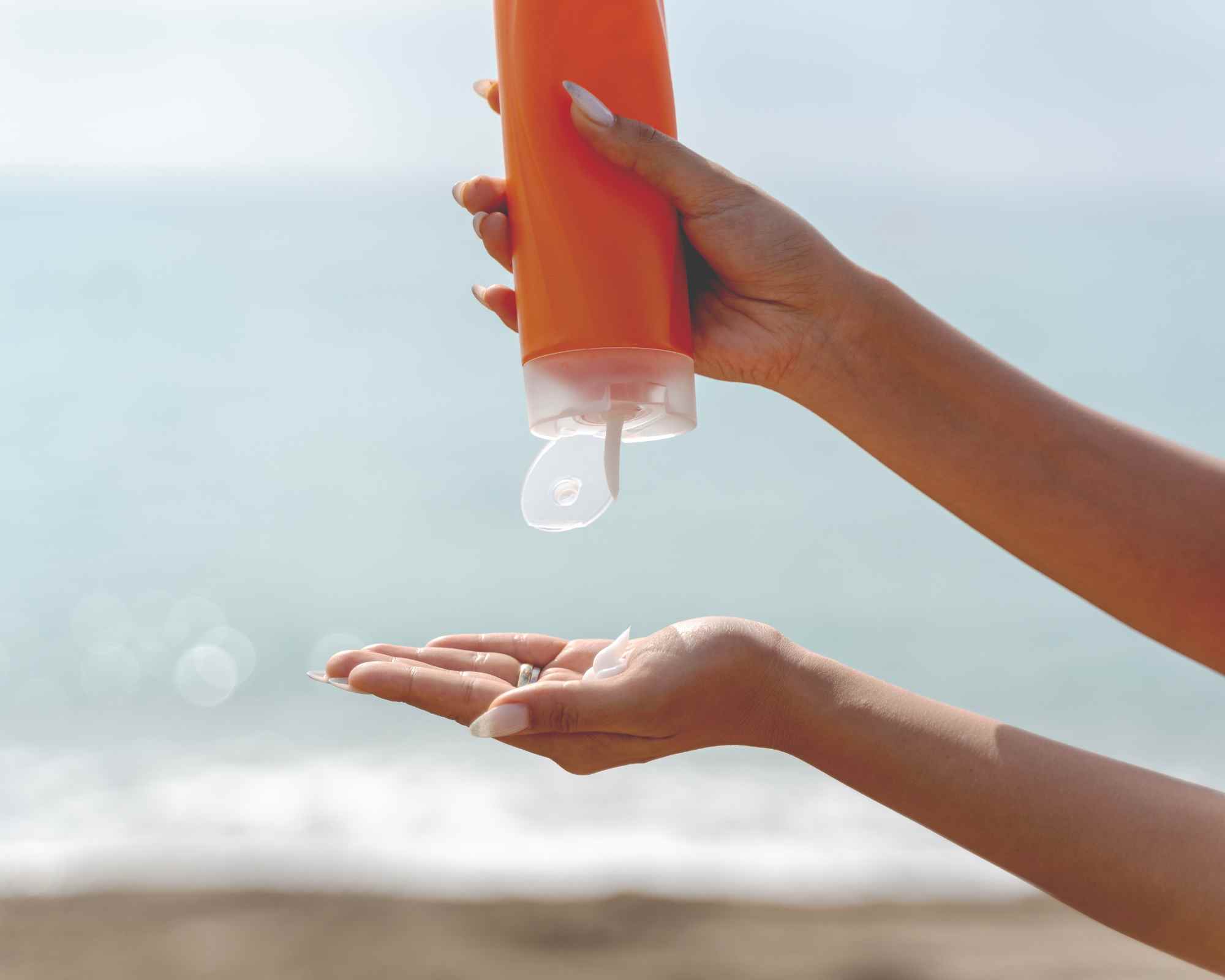Only a handful of brands are minimising the environmental impacts of their sunscreen products, according to new data from Good On You. Here’s what that means for the planet, and why more brands need to step up.
Sunscreen can harm the environment
Oxybenzone is a UV filter used in many of the most popular sunscreens. Recently, there’s been a lot of debate about its effects on human health. But while everyone talks about whether it’s safe for people to put on their skin, few are thinking about what happens when it washes off as they’re swimming in the ocean, or when it rinses down the drain in the shower. Concerns are only increasing around the fate and toxicity of beauty and personal care products when they’re released into the environment—and much is still unknown, says Becca Willcox, beauty ratings manager at Good On You.
You see, some of the key ingredients in sunscreens have been found to seriously harm aquatic life and pollute our waterways and oceans, to the extent that some regions have even banned them. And new data from Good On You’s analysts shows that most brands selling sunscreens aren’t minimising the use of such ingredients—even though it’s entirely possible.
How sunscreen impacts marine life
We know a lot about sunscreen’s ability to protect people from the sun’s harmful rays—and this article is not intended to dissuade you from using it. But research suggests that oxybenzone and other ingredients found in sunscreens can contribute to coral bleaching, cause defects in young sea urchins and mussels, disrupt reproduction in fish and marine life, impair photosynthesis and growth of green algae, and cause behavioural changes in marine life.
“The sunscreen industry enjoys its sales numbers from tropical tourist destinations, but it comes at a cost of jeopardising the environmental integrity of the natural resources that draw tourists to a region,” explains Craig Downs, executive director at the Haereticus Environmental Laboratory (HEL), which is an authority on sunscreen pollution science.
When Good On You’s analysts rated 239 beauty brands, some of which are the biggest in the world, they found that while 58% of them sell suncare products, only a fraction—just 15%—sell products that are free from known pollutants.
That’s a big deal, because it means that the majority of sunscreens out there are inflicting real damage on wildlife, waterways, and oceans.
And once they’re out there in the environment, these ingredients really persist—they’ve been found in oceans, rivers, and lakes and are reportedly hard to remove from wastewater at treatment plants. “Although the wastewater treatment process can remove some of these chemicals, others can persist in the environment and pose a potential threat to ecosystems and human health,” explains Willcox. On top of that, some research suggests that the effects of global warming—specifically heat stress and ocean acidification—are exacerbating the ecotoxicological effects of these ingredients.
A word on organic and inorganic UV sunscreen filters
It’s worth understanding that there are two different kinds of filters used in sunscreen: organic filters (also known as chemical filters), which are absorbed into your skin and convert UV rays into heat, which then dissipates from the skin; and inorganic mineral filters (also known as physical filters), which create a barrier on top of your skin to reflect UV rays away. From an environmental standpoint, inorganic filters are suggested to be the better option of the two, but both kinds can contain ingredients that impact the planet.
Common sunscreen ingredients that are known pollutants
Downs’ organisation, Haereticus Environmental Laboratory (HEL), has published a list of chemicals that threaten ecosystems and are known to pollute marine environments or cause harm to wildlife including corals, fish, birds, marine mammals, and sea turtles. Among the substances listed are two key ingredients in many organic sunscreens—UV filters oxybenzone and octinoxate.
Organic sunscreens have now been banned in Hawaii, the Virgin Islands, and elsewhere due to their impact on marine ecosystems. And while such ingredients are still used in the industry, legislation and consumer demands have had an impact on their popularity, says Downs. “The number of products containing oxybenzone has declined by nearly 90% since we [HEL] published our first paper in 2016. I do not think this is because the industry made a ‘positive’ change but because educated consumers desired products to be environmentally sustainable,” he cautions. “I think this was a textbook example of the purchasing power of the informed consumer to demand a massive change of course from industry.”
Also on HEL’s list are any nanoparticle zinc oxide or titanium dioxide, which are frequently used in inorganic sunscreens. Though this type of sunscreen is considered a better option than organic ones, there’s evidence to suggest that such tiny nanoparticles can be toxic to marine life, and this is in contrast to traditional—or, micro-sized—zinc oxide and titanium dioxide, which are potentially less impactful since they aren’t as soluble. Downs explains that there are a lot of variables when it comes to determining the exact impact of inorganic sunscreens. Notably, the purity and form of the ingredient, whether it is contaminated with heavy metals, or whether the final formulation of the sunscreen includes other ingredients that might cause it to degrade before it even leaves the container.
But it’s not easy to keep these ingredients out of products, because chemicals can even contaminate ingredients before they reach a manufacturer as a result of being used earlier in the supply chain in a formulation for an ingredient, as is often the case with camphors in fragrances. That’s why it’s so vital for manufacturers to trace their entire supply chains and commit to publishing full ingredient lists alongside their products. Ingredient formulators and high level executives in sunscreen manufacturers must also take responsibility for shifting away from chemicals that pose a risk to the environment, Downs says.
Certifications can prove helpful in avoiding ecotoxic ingredients, but Willcox advises caution around some claims of marine or reef-safe products: “Sometimes these claims aren’t substantiated or backed up with science or a certification,” she explains. “It’s an area open to greenwashing, so I’d suggest consumers look out for research-backed certifications, such as the Haereticus Environmental Laboratory’s Protect Land and Sea certification.” It helps to ensure that no chemicals on the HEL list have been included in a product at any point in the supply chain. When Good On You analyses beauty brands, we check if they’ve committed to avoiding the ingredients on the HEL list, if they’re certified under Protect Land + Sea, or if they confirm they only use non-nano zinc oxide and titanium oxide in mineral sunscreen.
Meet the brands taking ecotoxicity seriously
Shockingly, out of the beauty brands Good On You rated, only one—Tropic—has certified the majority of its suncare products (90% or more) under HEL’s Protect Land + Sea.
And just a handful of brands say their suncare products are free from pollutants on the HEL list, though they haven’t got a certification to confirm it. Among them are: Biotherm (“It’s a Start”), Weleda (“It’s a Start”), La Rosée (“It’s a Start”), Kora Organics (“Good”), Odylique (“Great”), BYBI (“Good”), Upcircle Beauty (“Good”), Unbottled (“Good”), Respire (“It’s a Start”), and Pai Skincare (“Good”).
As Good On You continues to rate beauty brands in the coming months and years, it’s likely more brands will be added to this list. But for now, our research—which was representative of the industry as a whole and included both large and small brands—shows that most businesses just aren’t doing enough. This striking discovery reveals the urgency for more scientific research about the effects of suncare ingredients in our waterways, and for the industry as a whole to take environmental damage more seriously.




















